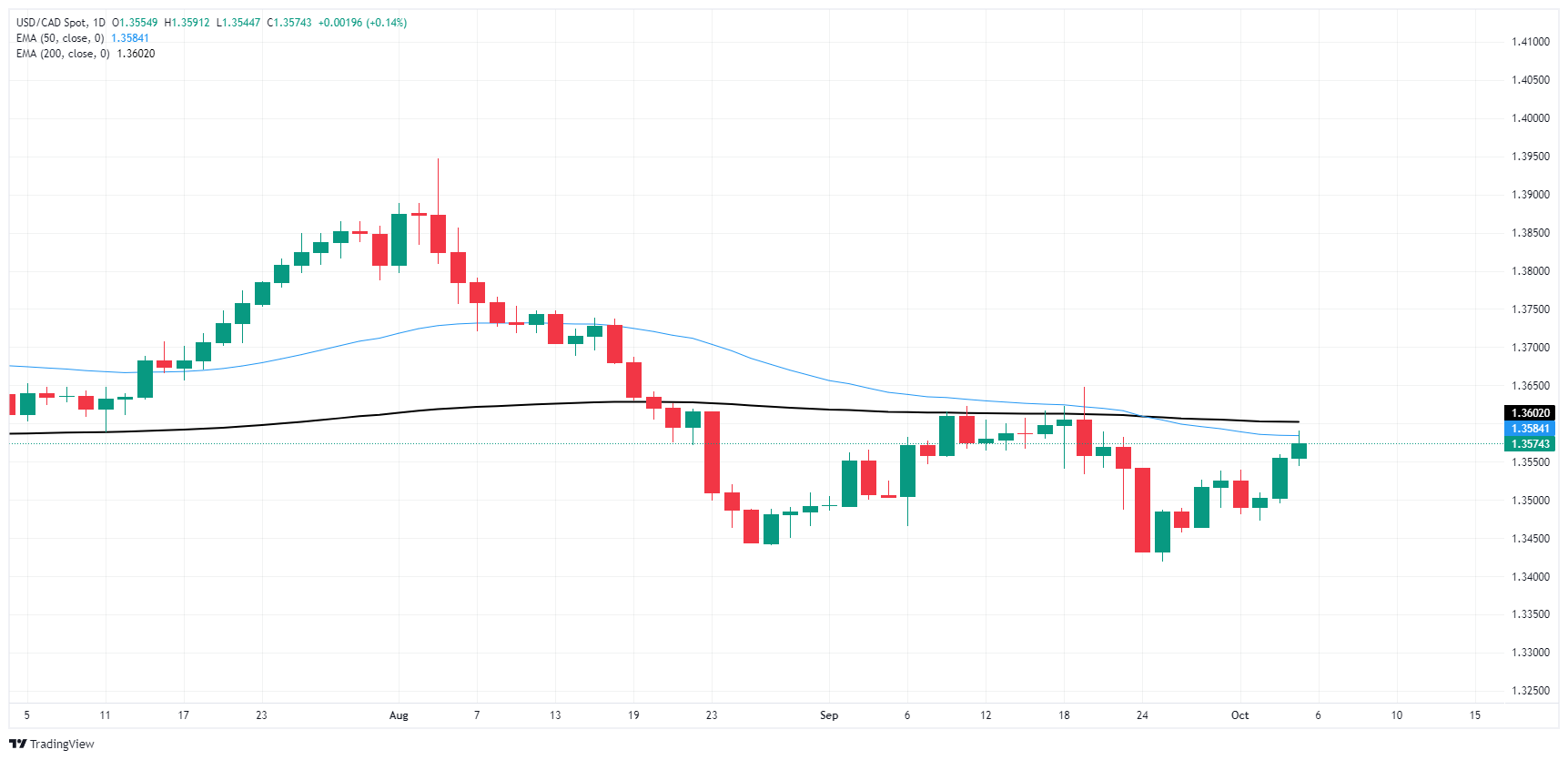- The Canadian Dollar (CAD) fell after better than expected US NFP data.
- Canada saw a rebound in Ivey PMIs, but it was ignored by market watchers.
- A sharp rise in US NFP job additions dashed rate cut hopes to close the trading week.
The Canadian Dollar (CAD) fell further on Friday, driven lower by a widespread extension of the recent dollar rally that sent the US Dollar higher across the board after Non-Farm Payrolls (NFP) numbers of the US will greatly exceed expectations.
Canada’s Ivey Purchasing Managers’ Index (PMI) rebounded in September, but the Canadian data was sidelined by investors entirely focused on US payrolls data. US NFP net job additions .US vastly exceeded expectations in September, with upward revisions to multi-month jobs numbers. The rapid change in the market outlook on the US labor market has largely changed the rate market’s bets on the Federal Reserve’s (Fed) rate cut in November.
Market drivers
- The Canadian Dollar lost a scant fifth of a percent against the Greenback on Friday.
- Canada’s Ivey PMI for September regained ground, rising to 54.9 after falling to 50.3 the previous month.
- US NFP jobs data largely beat expectations, adding 254,000 net new job additions in September compared to the forecast of 140,000. The NFP figure for August was also revised upwards to 159,000.
- The US unemployment rate also fell to 4.1% from 4.2% previously, further burying market hopes for a double Fed rate cut in November.
- According to the CME’s FedWatch tool, rates traders now see an overwhelming 95% probability of a single 25 basis point rate cut by the Fed on November 7, with a particularly beleaguered 5% expecting no move at all. .
- Hopes of a second 50 basis point rate cut in November have completely evaporated.
Canadian Dollar Price Forecast
The USD/CAD pair has been rising in recent sessions, finding itself at a critical point near the 50-day (1.3584) and 200-day EMA (1.3602). After a sustained downtrend from mid-August to early September, the pair has shown signs of stabilization, bouncing from the 1.3450 level.
This recent price action indicates that USD/CAD could be testing the upper limits of its consolidation range, with possible resistance near the 1.3600 level. Although the pair remains below the 50 and 200 day EMAs, the proximity of these moving averages suggests a significant technical resistance zone. A break above these levels could open the door for more gains, targeting the 1.3700 level.
On the downside, the pair appears to have found support around 1.3450, a key level that has acted as a floor in recent trading. A failure to hold above this level could lead to renewed selling pressure, potentially taking the pair back towards the 1.3350 region.
USD/CAD Daily Chart
The Canadian Dollar FAQs
The key factors that determine the price of the Canadian Dollar (CAD) are the level of interest rates set by the Bank of Canada (BoC), the price of oil, Canada’s main export product, the health of its economy, inflation and the trade balance, which is the difference between the value of Canadian exports and its imports. Other factors are market confidence, that is, whether investors bet on riskier assets (risk-on) or look for safe assets (risk-off), with the risk-on being positive for the CAD. As its largest trading partner, the health of the US economy is also a key factor influencing the Canadian dollar.
The Bank of Canada (BoC) exerts significant influence over the Canadian Dollar by setting the level of interest rates that banks can lend to each other. This influences the level of interest rates for everyone. The BoC’s main objective is to keep inflation between 1% and 3% by adjusting interest rates up or down. Relatively high interest rates are usually positive for the CAD. The Bank of Canada can also use quantitative easing and tightening to influence credit conditions, with the former being negative for the CAD and the latter being positive for the CAD.
The price of oil is a key factor influencing the value of the Canadian Dollar. Oil is Canada’s largest export, so the price of oil tends to have an immediate impact on the value of the CAD. Generally, if the price of oil rises, the CAD also rises, as aggregate demand for the currency increases. The opposite occurs if the price of oil falls. Higher oil prices also tend to lead to a higher probability of a positive trade balance, which also supports the CAD.
Although inflation has traditionally always been considered a negative factor for a currency, as it reduces the value of money, the opposite has actually happened in modern times, with the relaxation of cross-border capital controls. Higher inflation often leads central banks to raise interest rates, attracting more capital inflows from global investors looking for a lucrative place to store their money. This increases the demand for the local currency, which in the case of Canada is the Canadian Dollar.
The published macroeconomic data measures the health of the economy and may have an impact on the Canadian dollar. Indicators such as GDP, manufacturing and services PMIs, employment and consumer confidence surveys can influence the direction of the CAD. A strong economy is good for the Canadian dollar. Not only does it attract more foreign investment, it may encourage the Bank of Canada to raise interest rates, resulting in a stronger currency. However, if economic data is weak, the CAD is likely to fall.
Source: Fx Street
I am Joshua Winder, a senior-level journalist and editor at World Stock Market. I specialize in covering news related to the stock market and economic trends. With more than 8 years of experience in this field, I have become an expert in financial reporting.







